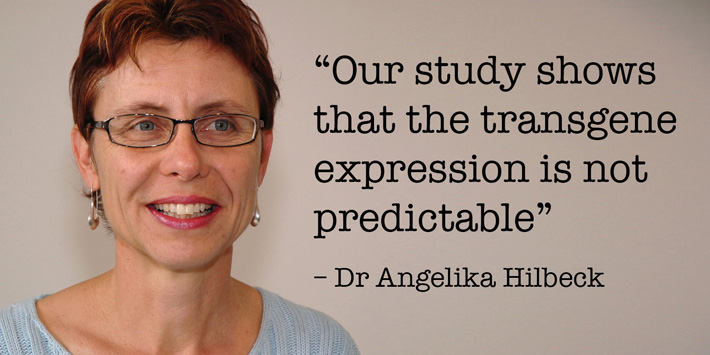
Dr Angelika Hilbeck talks about her new study showing the unpredictability of GM maize
Earlier today we reported on a new study that found unexpected reactions in GM maize MON810 when exposed to environmental stress.
According to the study’s authors, “Our findings challenge the general presumption that transgenes in commercially approved genetically modified plants are almost invariably expressed at high levels in all plant tissues” and during all phases of growth.
The researchers found “large variation in the transgene expression and Bt protein content caused by plant genetic background and environmental conditions”.
They stated that field-grown Bt maize plants might therefore not always produce high enough doses of Bt protein to kill Bt-resistant insect pests – thus increasing the likelihood of pest resistance to the Bt toxin.
Below, a co-author of the study, Dr Angelika Hilbeck of the Institute for Integrative Biology at ETH Zurich, answers our questions.
GMW: Please tell us more about your findings.
AH: Our study shows that the transgene is not the only factor controlling the protein (transgene product) expression: the genetic background of the plant also plays a role. In addition, the study shows that the transgene expression is not predictable. The transgene is necessary for the presence of the Bt toxin (no transgene, no toxin), but beyond this qualitative yes or no, in some varieties it has little or no influence on how much of the transgene product (Bt toxin) is expressed in which tissues of the Bt plant, and when.
We found that it is even more difficult to predict Bt toxin concentrations from transgene expression under stressful conditions. This runs counter to common assumptions that near total control over the expression process is possible, or at least that sufficient control can be achieved to make safety testing irrelevant.
GMW: What are the implications of your study?
AH: Our findings, in combination with those of other researchers regarding the expression of Bt transgenes in MON810[1], provide an evidence-based counter-narrative to the ‘control’ narrative. That in turn has real-world implications for GM applications for pharmaceutical or nutraceutical purposes when meant for direct consumption.
In the medical world, control over dose and timing of the administration of pharmaceutical substances is fundamental. Similarly, when crops are sold for the purpose of delivering certain nutraceuticals (functional foods, vitamins, proteins, etc.), guaranteed minimum doses beyond and above other non-transgenic varieties have to be reliable and enforceable to prevent fraudulent or misleading claims being made to consumers. Of course, also avoidance of unsafe upper doses must be guaranteed and enforceable. That will be tricky with this apparent lack of control.
Our study also has major implications for pest resistance management, which relies upon two conditions: a refuge where Bt-susceptible insect pests can survive and a consistently high expression of the Bt toxin in the GM plant, which is effective against the target pests everywhere in the world. The first condition, growing a refuge, is the sole responsibility of the farmer and can be enforced. The second condition, consistently high dose expression everywhere, is the responsibility of the producer of the GM crop. Yet according to our data, this is difficult, if not impossible, to control or enforce. So in the end, it is the farmer who has to deal with this problem by himself.
Notes
1. Agapito et al 2014 (http://www.biomedcentral.com/1471-2229/14/346/abstract) and 2013 (http://www.proteomesci.com/content/11/1/46) and Rosati et al. 2008 (http://www.ncbi.nlm.nih.gov/pubmed/18306044). Dr Hilbeck notes: "While these findings and those of the new study were on MON810, there is no reason to believe that other Bt maize varieties using similar transgene constructs/cassettes will be any different."









